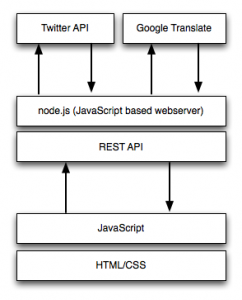Final Project Documentation
The idea for TwingRing originated from the idea of generating sound through Twitter streams. There might be some abstract interest in generating music from Twitter stream, but it is probably difficult to translate musical sense from sentential sense. It then occurred to me that text-to-speech is yet another form of computer mediated sound generation. It follows that having the computer to speak something is funny, having the computer speak tweets would be much funnier. In other words, it’s serious LOLz.
And thus the idea was born. The idea is then fleshed out; rather then simply converting text-to-speech, it would be much more interesting if it simulates a conversation between two parties. A duet of computer generated voices would create a “context” in which the conversation is happening. And the “context” of a conversation, to rewind through the progress of communication tools, would be something like a phone call. To add to the concept” of the project, the phone call would be decidedly traditional, sporting the familiar shrill Ring Ring to it, and the entire idea of not taking itself too seriously and hence kitschy was born.
On a serious note, TwingRing examines the notion of conversation between people, especially as communication mediums changed. The telephone was the first device that enabled remote communication between two people. Then the next game changer was the mobile or cell phone, which basically enables the same communication channel between two people. Then there was text, and more recently, the rise of social media tools, or social communication tools such as facebook and twitter. However, the notion of conversations do not change, but merely shifted as these tools enabled people to communicate differently. This project aims to examine how the idea of twitter conversations, when put into the context of a phone call, would sound like.
Actually, it’s really just for LULz.
There are a few technical pieces required for this to happen. Let’s look at the larger architecture.
There are a few technical pieces required for this to happen. Let’s look at the larger architecture.
The two main pieces that enables this piece is the Twitter API and the Google Translate API. There are a few parts to the twitter API. The current implementation uses the search API. The search API retrieves tweets based on a search term up to five days historically, which is a current big limitation of the system. The Twitter API is used to look for conversations from a particular user that mentions another user. This is done for both sides of the conversation. The retrieved tweets are then sorted chronologically so there is a guise of some sort of conversation going on. However, the way that tweets are used currently, @mentions are much less about conversations rather than simply “mentioning” another user.
When that is done, the message is then examined, common acronyms replaced with long form words, and then fed into the Google Translate API. The API has a “secret” API that returns a mp3 when fed with text. However, there is a 100 character limitation currently. The JavaScript examines the tweet and breaks them into 2 chunks if the tweet is longer than 140 characters. The name of the user is then used to check against a small list of database to determine the “gender” of the user. The mp3 is then fed to a flash based sound player, and pitch bent based on the “gender” of the user.
User interface is built in HTML/CSS with a heavy dose of JavaScript.
In retrospect, the project would have benefited from a stronger dose of humor. As the project iterated through from the rough design to the clean design, I personally feel that some of the kitschy elements are dropped in favor for a cleaner identity. However, there is definitely this whole notion of being able to play up the kitsch-ness of the site. There is still a need to rework some of the API elements to make it easier to work with. There is perhaps a problem with discovery of tweets by users, both because of the limitation in the search API as well as @mentions not being sufficiently dominant as a method of conversing on Twitter. There can be some more work done on that front, but what I have for now, is really, just kinda LOLz.
